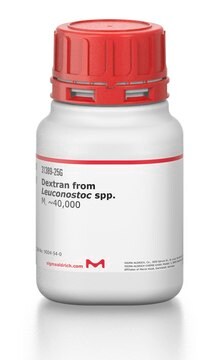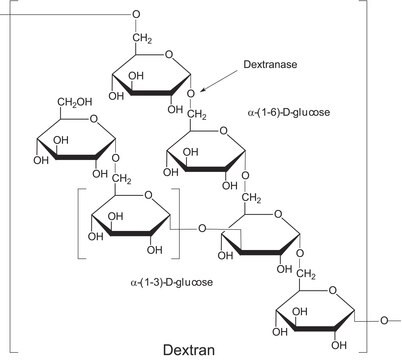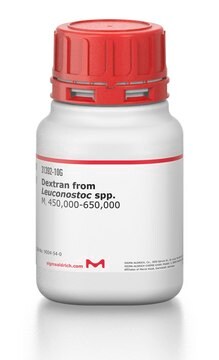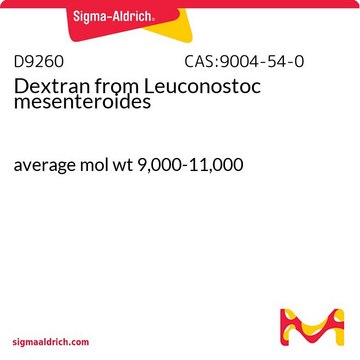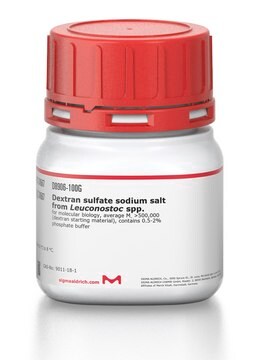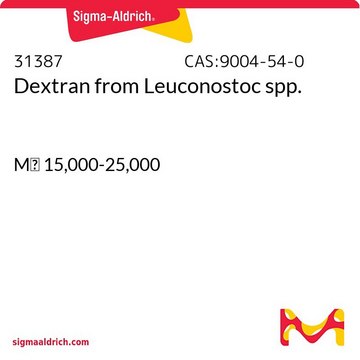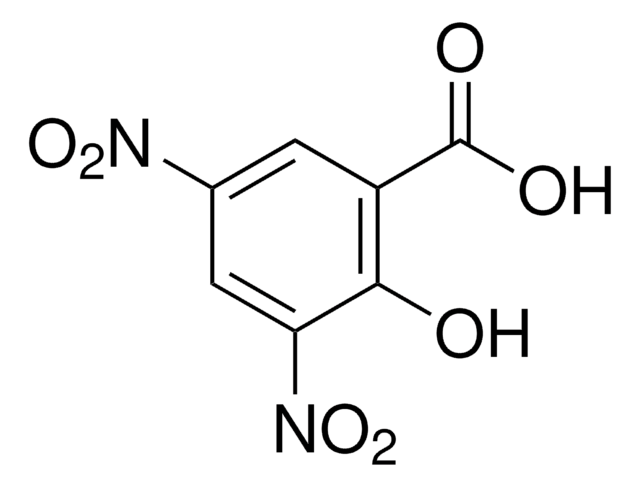D5884
Dextranase from Penicillium sp.
lyophilized powder, 10-25 units/mg solid
Sinonimo/i:
1,6-α-D-Glucan 6-glucanohydrolase
Autenticatiper visualizzare i prezzi riservati alla tua organizzazione & contrattuali
About This Item
Prodotti consigliati
Stato
lyophilized powder
Attività specifica
10-25 units/mg solid
Temperatura di conservazione
2-8°C
Cerchi prodotti simili? Visita Guida al confronto tra prodotti
Applicazioni
Dextranase from Penicillium sp. has been used in a study to assess a new method of synthesizing biopolymeric affinity ligands. Dextranase from Penicillium sp. Has also been used in a study to investigate the cloning and sequencing of a dextranase-encoding cDNA from Penicillium minioluteum.
Dextranase from Sigma has been used for the hydrolysis of carbohydate polymers, during the study of polysaccharide synthesis by Phanerochaete chrysosporium. It has also been used in the synthesis of new enzymatically degradable thermo-responsive nanogels.
Azioni biochim/fisiol
An endodextranase that hydrolyzes α-(1,6)-glucosidic linkages in dextran. Dextrans are undesirable compounds synthesized from sucrose by microbial contaminants during sugar production. They increase viscosity of the flow and decrease industrial recovery. Dextranase has been used for hydrolyzing dextran at sugar mills in order to improve efficiency of sugar production.
Qualità
Crude
Definizione di unità
One unit will liberate 1.0 μmole of isomaltose (measured as maltose) per min at pH 6.0 at 37 °C, using dextran as substrate.
Altre note
View more information on enzymes for complex carbohydrate analysis at www.sigma-aldrich.com/enzymeexplorer
Avvertenze
Danger
Indicazioni di pericolo
Consigli di prudenza
Classi di pericolo
Resp. Sens. 1
Codice della classe di stoccaggio
11 - Combustible Solids
Classe di pericolosità dell'acqua (WGK)
WGK 1
Punto d’infiammabilità (°F)
Not applicable
Punto d’infiammabilità (°C)
Not applicable
Dispositivi di protezione individuale
Eyeshields, Gloves, type N95 (US)
Scegli una delle versioni più recenti:
Certificati d'analisi (COA)
Lot/Batch Number
Non trovi la versione di tuo interesse?
Se hai bisogno di una versione specifica, puoi cercare il certificato tramite il numero di lotto.
Possiedi già questo prodotto?
I documenti relativi ai prodotti acquistati recentemente sono disponibili nell’Archivio dei documenti.
I clienti hanno visto anche
Polysaccharide synthesis by Phanerochaete chrysosporium during degradation of kraft lignin
Leisola M, et al.
Europ. J. Appl. Microbiol. Biotechnol., 15(3), 180-184 (1982)
Synthesis of new enzymatically degradable thermo-responsive nanogels.
Aguirre, G., Ramos, J., & Forcada, J
Soft Matter, 9(1), 261-270 (2013)
B Garcia et al.
FEMS microbiology letters, 143(2-3), 175-183 (1996-10-01)
A cDNA from Penicillium minioluteum HI-4 encoding a dextranase (1,6-alpha-glucan hydrolase, EC 3.2.1.11) was isolated and characterized. cDNA clones corresponding to genes expressed in dextran-induced cultures were identified by differential hybridization. Southern hybridization and restriction mapping analysis of selected clones
H Roca et al.
Yeast (Chichester, England), 12(12), 1187-1200 (1996-09-30)
The DEX gene encoding an extracellular dextranase was isolated from the genomic DNA library of Penicillium minioluteum by hybridization using the dextranase cDNA as a probe. Comparison of the gene and cDNA sequences revealed that the DEX gene does not
G S Chaga et al.
Biotechnology and applied biochemistry, 26 ( Pt 1), 7-14 (1997-08-01)
(1) A new concept for producing soluble polymeric affinity ligands is proposed and exemplified. By solid-phase synthesis, an insoluble hydrophilic polymer is converted into an affinity gel. The gel is hydrolytically degraded to water-soluble affinity polymeric ligands which are recovered
Il team dei nostri ricercatori vanta grande esperienza in tutte le aree della ricerca quali Life Science, scienza dei materiali, sintesi chimica, cromatografia, discipline analitiche, ecc..
Contatta l'Assistenza Tecnica.